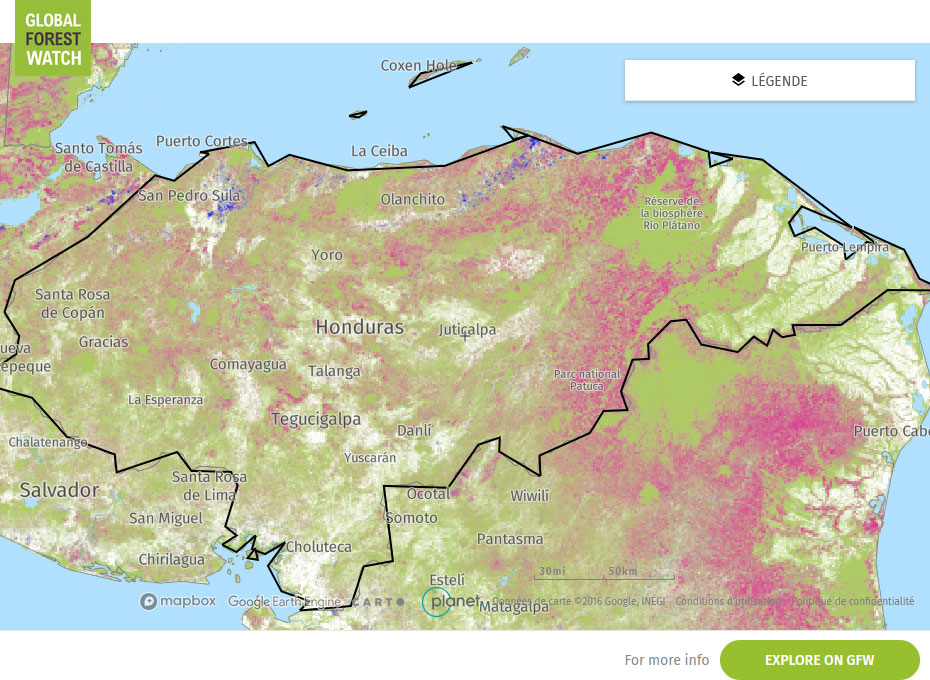Forest resources and context of Honduras
The total forested area of Honduras has been reassessed at 6.3 million hectares (ha), equivalent to 56% of the national territory, not including agroforestry, secondary vegetation, savannahs and other forms of vegetation cover.

Land surface
11.2million ha
Forest cover
4.6million ha
Production forest
0.9million ha
Forest ownership
62.0% publicly
Forest resources in Honduras
Types of forest
Broadleaf forests, with 4.1 million ha, represent 64.5% of the total Honduran forest area; they are located mainly in the lower North and East parts of the country, where rainfalls are abundant and well distributed throughout the year. The coniferous (pine) forests with 1.9 million ha then make another 30.9% of the total forest area; they are located in the high central parts of the country and form the second major ecosystem of Honduras. Mixed forests with 0.239 million ha represent another 3.8% of the total forest area. Mangroves and flooded forests, with 50,165 ha, only represent 0.8% of the forest area but they constitute an irreplaceable and unique ecosystem that houses an incredible biodiversity. (ICF, Area and types of land cover in the Republic of Honduras).
The forests of Honduras are biologically very diverse, but only a few tree species are the subject of significant timber trade. Pine forests are mainly represented by 7 species of the Pinus genus that constitute the basis of the primary wood-processing industry of the country. Oocarpa and caribea pines (Pinus oocarpa, Pinus caribea) are, by far, the most important. Other important hardwood timber species include Santa María (Calophyllum rasiliense), Laurel (Cordia alliodora), Ceiba (Ceiba pentandra), Tamarindo (Dialium guianense), San Juan (Vochysia guatemalensis), Masica (Brosimum alicastrum), Sangre (Pterocarpus officinalis Jacq.), Caobina (Virola koschnyi), Cumbillo (Terminalia amazonica); Caoba del Atlántico (Swietenia macrophylla); Cedro macho (Carapa guianensis); Cedro real (Cedrela odorata), and Macuelizo (Tabebuia rosea), all hardwood species.
According to the new map of forest cover and land use of Honduras that was built in 2018, the total forested area of Honduras has been reassessed at 6.3 million hectares (ha), equivalent to 56% of the national territory, not including agroforestry, secondary vegetation, savannahs and other forms of vegetation cover.
At the end of 2018, the growing area under forest management reached 421,773 ha (2016: 278,720 ha), in 871 management plans currently in force (2016: 614), with an estimated productive capacity (annual growth) of 700,554 m3 per year (2016: 551,362 m3), and it is distributed according to land tenure as follows (Source: ICF Forest Statistical Annuary 2018, Chap. 3):
- 50 Management plans on national land with 101,273 ha;
- 15 Management plans on Ejidal (municipal) land with 67,342 ha; and
- 806 Management plans on private land with 252,922 ha.
In terms of deforestation, most of the forests that are located close to urban centres have been exploited without proper control to be used for firewood and raw construction timber. The total loss of forest in Honduras over 2000 – 2016 was approximately 372,857 ha, with an average annual loss rate of 23,304 ha/yr (2006 – 2012 being the period with the greatest deforestation rate). The ecosystem that was most affected by deforestation is the evergreen broadleaved rainforest, with an average loss of 17,408 ha/yr, followed by the deciduous broadleaved forest (3,187 ha/yr), the coniferous forest (2,635 ha/yr) and the mangrove forest (75 ha/yr).
The average recovery of forests in Honduras over the same period was 2,353 ha/yr (2000 – 2006 being the period with the highest increase). The ecosystem that presented the greatest activity in terms of forest recovery is the broadleaf rainforest with an average annual gain of 1,285 ha/yr. (ICF, Forest Statistical Annuary 2018, Chap. 2)
Forest ownership in Honduras
About 62% of the national forest area is publicly owned, including national forests (40%) and protected forests (18%). The remaining 38% of the national forest area is under private ownership, which includes privately owned forests, community forests and tribal forests. However, the possession and traditional usufruct of national forests by settlers without definition of ownership have given rise to different denominations of different usufruct regimes in various parts of the country. The regularization of the rights of settlers in national forests is still a preponderant factor in the rational use of these resources and therefore an important variable of socioeconomic development in the country. In the last 10 years, several governments have recognized public lands for indigenous communities and some legal representatives have been delegated to manage and harvest forests. This process is being used in various parts of the country and does not alter state property. (MOSEF Project, 2017)
key figures
| Land surface | 11.2 million hectares |
|---|---|
| Forest cover | 4.6 million hectares (41%); mostly other naturally regenerated forest) |
| Production forest | 0.9 million hectares designated for production |
| Forest ownership | 62.0 % publicly owned 38.0 % privately ownedd |
| Annual change rate | -2.3% per year; over the past 25 years (1990-2015) |
Source: FAO, 2015
See also: Global Forest Ressources Assessment 2020, FAO



